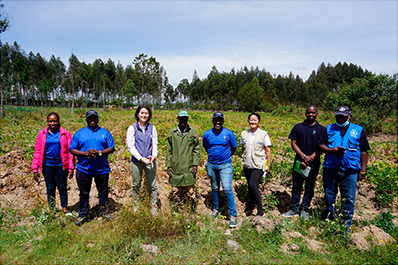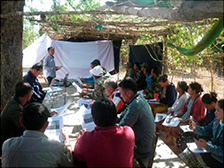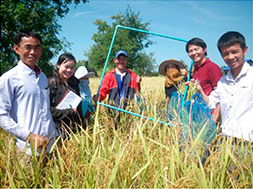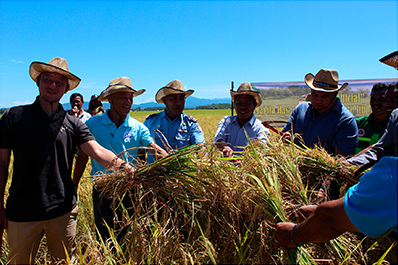(8) Food Security and Nutrition
Amid the lingering effects of COVID-19, Russia’s aggression against Ukraine has severely affected the global food security, Note 80 causing soaring food prices and supply chain disruptions. According to the report of “the State of Food Security and Nutrition in the World 2022,” Note 81 between 702 and 828 million people were estimated to be in hunger in 2021. This number increased by approximately 150 million since the global spread of COVID-19, showing an increase of 46 million in 2021 alone. The report also predicts that 670 million people, which accounts for 8% of the world’s population, will still be affected by hunger in 2030. As this ratio is the same level as the proportion of undernourished people in 2015 when SDG 2 “Zero Hunger” was launched, the report notes that immense efforts are required to achieve the SDGs. In September 2021, the “UN Food Systems Summit” was held for the first time at the call of UN Secretary-General Guterres, for the purpose of realizing recovery from the effects of the COVID-19 pandemic, as well as achieving the SDGs by 2030. This Summit advocated that all people take action toward the transformation of “food systems,” which consist of food production, distribution, and consumption, in order to ensure global food security.
● Japan’s Efforts
Japan proactively addresses food-related problems as a global issue, giving priority to cooperation for the promotion of agriculture, forestry, and fisheries, including the development of food value chains. Glossary In the short term, Japan provides food assistance to developing countries to avert food shortages. In the medium- to long-term, it aims to help increase and improve agricultural production and productivity in developing countries in order to prevent and eliminate the causes of food-related problems including hunger (see also “Stories from the Field 4,” and “Project Introduction Columns” on Laos, and on Tanzania, Kenya, Côte d’Ivoire, Ghana, and Nigeria for assistance regarding enhancement of rice and agricultural production).
■ Efforts to Provide Food Assistance and Improve Nutrition

Japanese staff members of WFP (dispatched under the JPO Programme) who support smallholder farmers to improve agricultural productivity, ship produce, and gain access to markets in the “Connecting Smallholder Farmers to Markets” program in Kenya pictured with the farmers receiving support (Photo: WFP)
Japan provides food assistance based on requests from developing countries facing food shortages. In FY2022, Japan contributed a total of 7.8 billion yen to 27 countries and one region as a grant mainly with the provision of Japan’s Government-Owned Rice.
In addition to bilateral support, Japan is engaged in efforts to provide food assistance in cooperation with international organizations. For example, through the World Food Programme (WFP), Japan supports school meal programs to improve access to education, as well as initiatives to encourage people to participate in the development of agricultural land and social infrastructure through the distribution of food. In 2022, Japan contributed grant aid of 200 million yen each in February and August through WFP to Sierra Leone, which chronically faces food shortages, with the provision of Japan’s Government-Owned Rice, as well as beans and vegetable oils. In 2021, WFP conducted activities including the distribution of approximately 4.4 million tons of food and food assistance based on cash transfers to approximately 128 million people in 80 countries around the world. Japan contributed a total of approximately 226.19 million US dollars to the WFP projects in 2021.
Furthermore, Japan supports the improvement of nutrition in developing countries through contributions to the multilateral development banks (MDBs). In 2021, Japan announced additional contributions totaling 70 million US dollars to the World Bank’s Global Financing Facility (GFF) Glossary and the Japan Trust Fund for Scaling Up Nutrition. Glossary In addition, from the perspective of mainstreaming nutrition in development policy, Japan hosted the 20th replenishment final meeting of the International Development Association (IDA) of the World Bank Group in December 2021, and included in its agenda the strengthening of human capital, including improving nutrition status, as a priority area.
In addition, Japan hosted the “Tokyo Nutrition for Growth Summit 2021” in December 2021 and issued the “Tokyo Compact on Global Nutrition for Growth” as the outcome document of the Summit. More than 27 billion US dollars in nutrition-related financial contributions was announced by governments and other stakeholders at this Summit, including Japan’s contribution of more than 300 billion yen in nutrition-related assistance announced by Prime Minister Kishida. Japan promotes cooperation for improving nutrition in the international community based on the outcomes. Specifically, Japan works with WFP to provide grant aid for food and nutrition assistance to displaced persons from Myanmar in Bangladesh. Japan also works with the United Nations International Children’s Emergency Fund (UNICEF) to provide specialized nutritional foods to children, pregnant women, and nursing mothers in Timor-Leste.
Laos
Regional Agricultural Revitalization through Cooperation between the Provincial Government and Farmers
The Project for Participatory Agriculture Development in Savannakhet Province
Technical Cooperation Project (June 2017 – June 2022)
Savannakhet Province, located in the southern part of Laos, is a region with thriving agriculture centered on rice cultivation. However, the cultivation techniques that the provincial government strives to spread had not fully spread among farmers, and this had been a factor in the low yield. In response to the situation, this project aimed to increase farmers’ productivity and income by supporting them to proactively improve their cultivation techniques, in partnership with officers and extension workers from the Provincial Agriculture and Forestry Office (PAFO) in Savannakhet.
The project started with understanding the needs of farmers by setting up meetings in which the provincial officers and extension workers held direct discussions with farmers. As the farmers faced serious challenges in securing funds and rice seeds for the next crop in the aftermath of the torrential rains in 2018, “Strengthen Cultivation Techniques by Rice Seed and Fertilizer Lending Program” was launched to provide support to them. This loan program required farmers to attend training in order for rice cultivation techniques to be shared with them. The farmers used loaned quality seeds and fertilizers while utilizing and practicing the cultivation techniques attained through the training. As a result, the unit yield of rice increased by 31% compared to the level before the start of the project. In addition, 74% of the farmers participating in the training (2,803 people in total) continued to use the cultivation techniques.
Furthermore, the project helped the province cooperate with private institutions to enable the province to operate its own loan program, and obtained the cooperation of a Lao bank. In Savannakhet Province, the loan program continues even after the completion of this project and the farmers purchase quality seeds and fertilizers with their increased income, which shows sustainability.
It is expected that farmers, provincial officers, and extension workers will continue to work together to further revitalize local agriculture.

Implementation of training on rice farming techniques (Photo: JICA)

Extension workers, farmers, JICA officials, and project staff conducting a yield survey to confirm the results of the training on rice farming techniques (Photo: JICA)
■ Establishment of Food Value Chains and Promotion of Agriculture, Forestry, and Fisheries

Harvesting rice in a domestic rice harvesting festival held under the “Project for Increasing Farmers Households’ Income through Strengthening Domestic Rice Production in Timor-Leste” (Photo: JICA)
In developing countries, low purchase prices for agricultural products are one of the factors that prevent many farmers from escaping poverty.
Japan promotes the establishment of food value chains for developing countries in cooperation with private companies. In FY2022, based on the “Plan to Promote the Establishment of Global Food Value Chain,” which defines priority initiatives to establish a food value chain in each country and region, Japan organized bilateral policy dialogues with Thailand and Palau.
Moreover, Japan places emphasis on agriculture as an essential industry that plays an important role in Africa’s economic growth, and actively contributes to its development. Specifically, under the Coalition for African Rice Development (CARD) Glossary Phase 2, Japan proceeds with efforts to improve the quantity and quality of rice production applying the RICE approach. Glossary The approach includes support for the development of irrigation facilities, research on superior rice varieties including New Rice for Africa (NERICA), Glossary a hybrid of Asian and African rice varieties, and dissemination of production technology. CARD targets have expanded to 32 countries (see also “Stories from the Field 4” for the efforts by CARD).
In TICAD 8 held in August 2022, Japan set the goal to provide human resources development for 150,000 people and to realize a doubling of rice production (56 million tons) by 2030 through CARD.
Moreover, in order to transform agriculture from self-sufficient to “income generating” activities, Japan provides assistance through the Smallholder Horticulture Empowerment & Promotion (SHEP) approach. Glossary The SHEP approach refers to an effort to assist smallholder farmers producing fruits and vegetables, aimed at increasing their income by causing a mindset shift to “growing to sell” and through improvements to farm management and cultivation skills. Japan has so far provided training and dispatched experts to 29 countries in Africa to support the transformation from the existing subsistence agricultural model. Japan expressed at TICAD 8 that it would support 66,000 people’s shift to agriculture for “earning” through the SHEP approach. Japan also stated that it would provide 300 million US dollars through co-financing to support the strengthening of food production in coordination with the African Development Bank’s African Emergency Food Production Facility.
■ Food Security through International Organizations
Japan has been involved in the development of the “Agricultural Market Information System (AMIS)” Note 82 in order to contribute to the improvement of food security through the enhancement of transparency in international agricultural markets. Japan contributes to project costs of AMIS while sharing information on Japan’s experiences.
Japan also provides assistance in the agricultural sector through international organizations such as the Food and Agriculture Organization of the United Nations (FAO), the International Fund for Agricultural Development (IFAD), the Consultative Group on International Agricultural Research (CGIAR), and WFP in order to strengthen developing countries’ own foundations for food production. For example, Japan, in partnership with FAO, provides assistance in technical cooperation for the agricultural and rural development of developing countries, the establishment of international standards and norms in the food and agriculture fields, and the development of statistics. In April 2022, Japan provided seeds, fertilizers, etc., to smallholder farmers in Ukraine. In July, Japan also provided food-related assistance in response to the impact on the global food security caused by the situation in Ukraine. As part of this effort, Japan decided to provide food-related assistance mainly to the Middle East and Africa and support the expansion of Ukraine’s supplemental grain storage capacity to facilitate its grain exports. Japan also supports research and development aimed at both increasing productivity and sustainability, including variety development, the introduction of digital agricultural technologies, and other efforts conducted by CGIAR, which is comprised of 15 international agricultural research institutions.
In addition to the above-mentioned assistance in the agricultural sector, Japan contributes to the enhancement of animal hygiene through the World Organisation for Animal Health (WOAH) and FAO. For example, Japan participates in the “Global Framework for the Progressive Control of Transboundary Animal Diseases (GF-TADs),” established by WOAH and FAO in response to transboundary animal diseases such as Avian Influenza, Foot-and-Mouth Disease (FMD), and African Swine Fever (ASF), supporting the initiatives of international organizations in the field of animal hygiene mainly for the Asia-Pacific region.
Glossary
- Food Value Chain
- An activity in which various stakeholders cooperate, including the farmers, suppliers of farming materials and implements, such as seeds, fertilizers, and farming machinery, processing companies of agricultural produce, transportation and distribution companies, and retailers, aiming at creating a chain that can enhance the added value of agricultural produce from the stages of production, to manufacturing and processing, distribution, and consumption. For example, it includes improving the quality of agricultural produce, developing attractive new products, reducing transportation costs, increasing sales opportunities by expanding the sales network, and other activities.
- Global Financing Facility (GFF)
- An initiative launched in 2015 by the World Bank, the UN, and others to expand financial resources for the maternal and child health field. The GFF provides technical assistance for the formulation of maternal and child health policies, including those to improve the nutritional status of women and children, and for the enhancement of implementation capacity. The GFF aims to mobilize funds effectively by providing support to formulate plans with the pre-condition that low-interest loans from the World Bank and other sources are used to implement said plans.
- Japan Trust Fund for Scaling Up Nutrition
- A trust fund established in 2009 to scale up nutrition investments in high undernutrition-burden countries and to strengthen in-country capacity to implement nutrition programs. It provides technical assistance to high undernutrition-burden countries to formulate policies for improving nutrition and to improve their implementation capabilities, thereby boosting nutrition investments by the countries concerned and the World Bank.
- Coalition for African Rice Development (CARD)
- A consultative group composed of donor countries, African regional organizations, and international organizations, partnered with rice-producing countries in Africa that are interested in rice production and development. It was proposed and launched by Japan at TICAD IV in 2008 to support self-help efforts toward the expansion of rice production in Africa. Japan also launched the CARD Phase 2 at TICAD 7 in 2019.
- Resilience, Industrialization, Competitiveness, Empowerment (RICE) approach
- An initiative adopted under CARD Phase 2 to realize the goal of doubling rice production in Sub-Saharan Africa. Specific efforts include stabilizing production through adaption to climate change and population growth, industrial formation in local areas in cooperation with the private sector, enhancing the quality of home-grown rice so that it can compete with imported rice, and establishing agricultural management systems to improve the household incomes and livelihoods of farmers.
- New Rice for Africa (NERICA)
- A general term for rice developed in 1994 by the CGIAR Africa Rice Center through the hybridization of high-yield Asian rice with weed, disease, and insect pest resistant African rice. In order for NERICA to suit the natural conditions of each region in Africa, they are characterized by (i) a higher yield, (ii) a shorter growth period, (iii) higher resistance to dryness (drought), and (iv) higher resistance to diseases and insect pests than conventional rice. Since 1997, Japan has partnered with international organizations and NGOs and has provided support for research and development related to new types of NERICA, test cultivation, and increased production and popularization of seeds. In addition, Japan has dispatched agricultural experts and JOCVs to offer cultivation training and has also accepted trainees from Africa for training in Japan.
- Smallholder Horticulture Empowerment & Promotion (SHEP) approach
- An approach started by Japan in Kenya in 2006 to assist smallholder farmers producing fruits, vegetables, and other produce. It aims to increase their income through converting farmers’ mindset from “grow and sell” to “grow to sell” and by improving farm management and cultivation skills. Japan promotes the activities integrating the SHEP approach around the world with a focus on Africa.
- Note 80: A state where all people, at all times, can access sufficient, safe, and nutritious food.
- Note 81: A report jointly prepared and published by FAO, IFAD, WFP, UNICEF, and WHO.
- Note 82: A system launched in 2011 by the G20 as a measure to counter the wild fluctuations of food prices. Various countries, corporations, and international organizations utilize the system to share information on the agricultural and food market (such as production volumes and prices) in a timely, accurate, and transparent manner.
